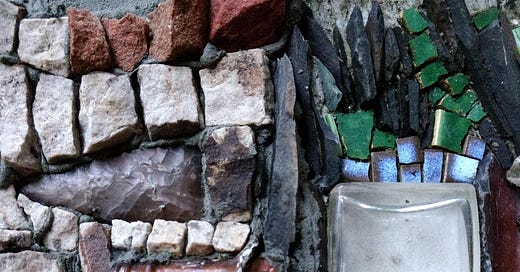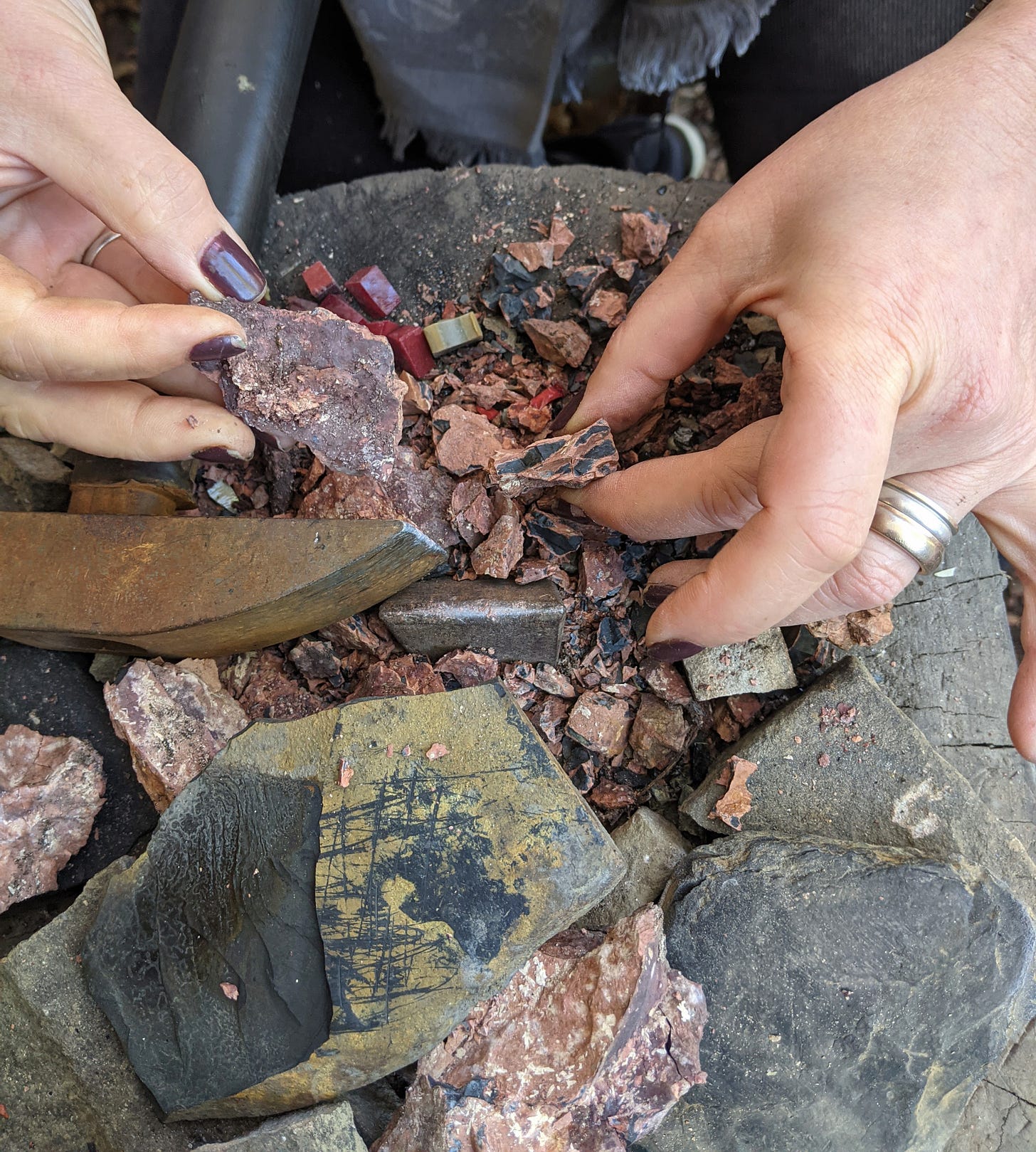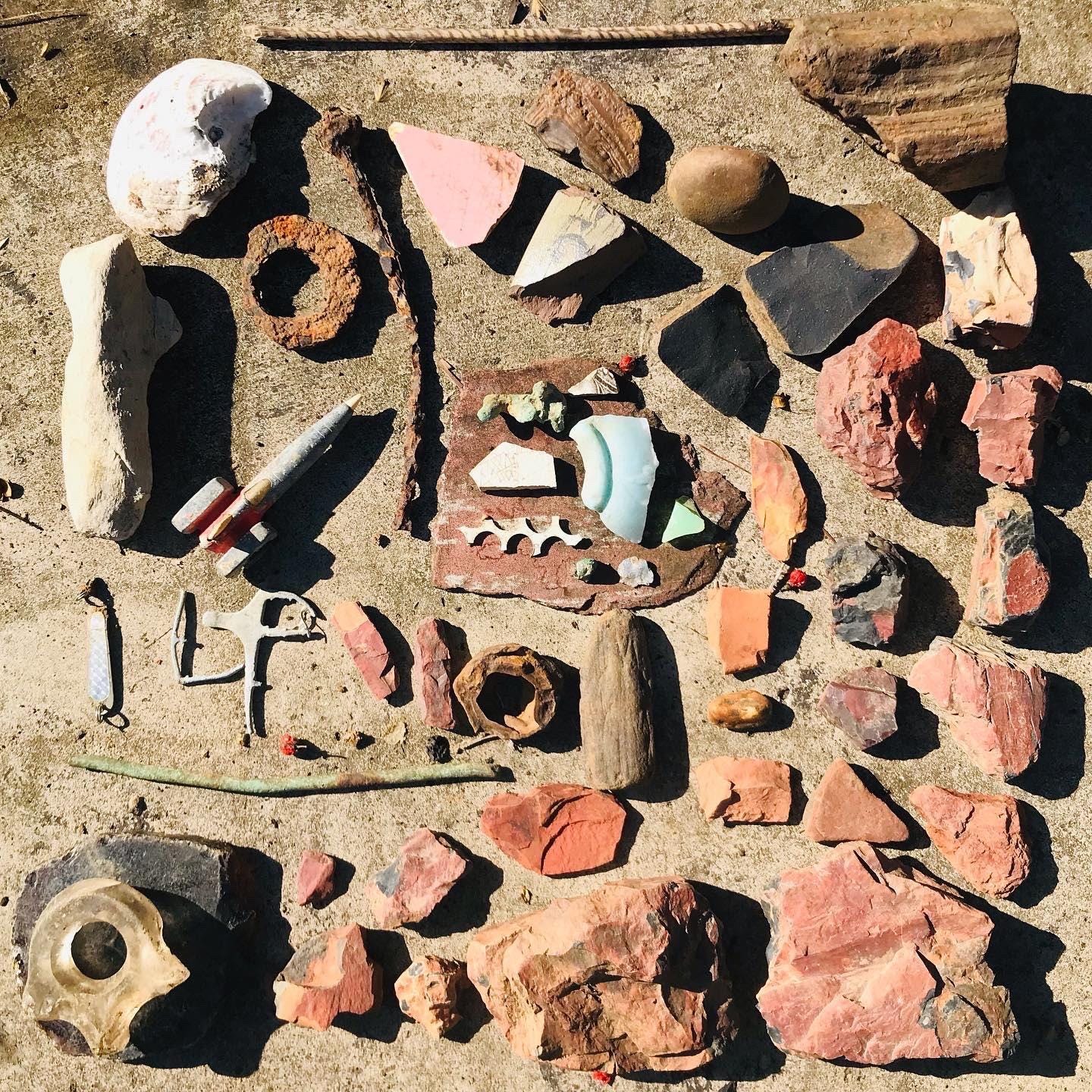First, find a small, beautiful thing. Then, think about it.
Sound overly simplified? It is. And it’s not.
Let me break it down for you.
Let’s use our example of the small, beautiful thing as a piece of river glass. River glass is similar to sea glass, but instead of the ocean, its rounded corners and aged patinas have come to be by rolling around in a river. In my experience, river glass is a bit clearer and less frosty in quality than its more famous sea glass cousin.
The one you are imagining with me is a clear, deep amber that the sun hit at just the right moment for you to pause and zoom in on it.
Note: your beautiful thing example can be a stone, a shard of ceramic, a piece of plastic, a sheet of metal, or even a particular kind of wood. Remember, if it can be cut, it can become a mosaic.
Step #1: Cradle It.
Not just in your hands, but in your mind.
Like a wolf pup in its first few weeks, imprint with it. Fall in love with it.
Think on why it pulled at you. Was it the color? or the shape? the texture? Was it because it feels like fate turned your head, and against all odds, at just the right moment, you didn’t pass it by? Give yourself a well-deserved pat on the back for being the lucky (or perceptive) one to find it. Appreciate its curves. Its shades.
You might raise it to your nose and smell it.
You might, if you are a certain kind of person, even lick it.
Step #2: Bring it Home.
Move it to a place where it can be rinsed clean and set amongst other things like it. Line it up against the other beautiful things and notice how it might change in relation to them.
Create a category for it. Its category might be size, shape, texture, color, provenance.
That’s up to you.
Step #3: Look for Its Origin Story.
And if that fails, make one up.
With the pieces of what you know about your beautiful thing, imagine how far it traveled down its river. Look at a map and follow its trail back to other rivers. Water is the most powerful force on earth. Anyone who has seen toilets and shopping carts in the creeks behind their house, understands this. Think of the fish kisses this little triangle of brown glass may have experienced. Think of the recipe of sand, silica, oxide, and iron that was mixed by men in a long-ago factory. Picture them pouring its hot alchemy out of a giant crucible and onto a wide steel plate.
Imagine another man drinking the beer this piece of a bottle once held, maybe getting drunk and stumbling into a ditch where he discarded it. Imagine the rest of its pieces, buried in the mud of some far-off, other river.
Your imagination, like the river, is a powerful force.
Step #4: Do Things to It
Transfigure your beautiful thing from something raw in the landscape into something with intention that lives in a new, important place. The doing things may involve getting in front of a teacher. Learning and luxuriating in the tools of the trade.
Hammers, nippers, tweezers. Mortar, glue, substrate. Andamento, architecture, composition. Gather the language and the people of mosaic around you.
This step will take the most time.
It may take the rest of your life.
Step #5: Go Back and Find More
Add to your beautiful thing until you have piles of beautiful things. Create a library of things so when you are back at step #4, and you need a subtle shade of red sandstone or a smooth, transparent bottle green, you will know that it is there, waiting for you.
Step #6: Connect Its Old Story to a New Story
Make connections between the old and the new that matter to the people in front of you.
This may be the most complicated of the steps. But, also the most fun. This is where talking and writing may become important. And the building of relationships.
You don’t need to talk and write to an audience. One other person may be all you need.
This step has overlaps with Step #3 but if it comes after the doing things part, your perspective is deeper. You may find that making connections with the other people comes more easily now. Maybe you will meet someone who grew up in the shadow of that old glass factory.
Maybe their grandfather made the glass. Or maybe he drank the beer.
Their memories can help you build an infrastructure of trust. Trust is necessary when asking someone to unearth their past. Because the past can be muddy. And sometimes the mud can be layered with pain.
Step #7: Repeat the Whole Experience Many Times.
Return to the river. Remember your special spots. Because a woman never steps in the same river twice. It will be different. And you will be different.
The act of repetition cannot be separated from the art of mosaic.
Embrace each return to the river as you embrace the pieces of things themselves.
Congratulations! You are now a mosaicist.
But not just any mosaicist. You are a storytelling mosaicist. Which is the best kind.
You have the power to pull stories from the very earth itself. You have unique knowledge to see possibilities that are hidden from most people. You are in an elite group that can change the world with pieces of things.
You don’t just make mosaic. You make time traveling mosaic.
And it all starts with one beautiful thing.

This piece of writing feels important. It feels like it belongs in the book that I think I am writing. I want to take a moment to thank you, sincerely, for being a part of these last few months, encouraging me to keep swimming in the deep end of the being a writer ocean. I am most definitely not feeling my toes hit the bottom, so I just keep on paddling.
If reading these carefully curated and thoughtful posts is making a difference in how you see your creative world, you might decide to become a paid subscriber and make a direct-to-the-creator kind of impact.
I promise you, it will make a difference.
Thank you for being here, as I work out my problems on the page.
Rachel











A woman never steps in the same river twice..wow
This "piece" (writing piece...) is EVERYTHING. Thank you for articulating it all so perfectly, Rachel. I love the part about noticing - and collecting - objects that catch your eye but for which you do not yet know the purpose. I have been doing this unconsciously for years and now....I shall do it consciously. In my studio I have a postcard print of a beautiful piece of art that bears the words, "THERE ARE MANY BEAUTIFUL THINGS." I've had it tacked up on my studio wall like a mantra.